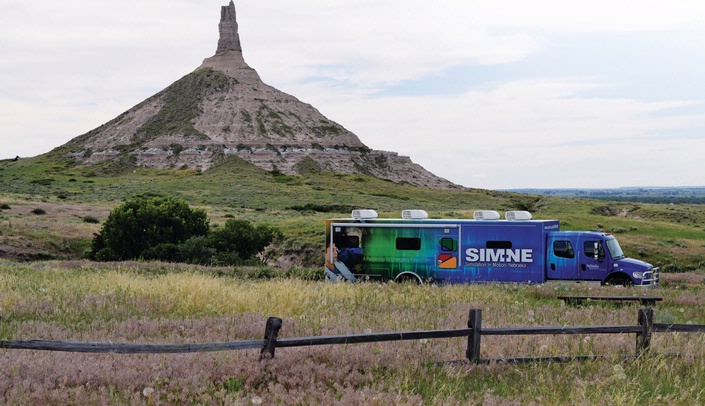Medical emergencies require the response of highly trained health professionals.
Now, four high-tech rolling classrooms deliver training free to emergency medical service agencies and critical access hospitals in every corner of Nebraska.
In June, Simulation in Motion Nebraska trucks (SIM-NE) were sent to four cities – Kearney, Norfolk, Lincoln and Scottsbluff – to provide real-life training experience and increase life-saving training opportunities through high-tech simulation. The UNMC College of Nursing has educational divisions in these cities and the College of Allied Health has programs in Kearney.
The customized trucks are funded by a $5.5 million grant from The Leona M. and Harry B. Helmsley Charitable Trust. Each truck cost $1 million and operations, provided by UNMC, are paid for through the grant in a step-down process over three years.
"We’re bringing high-fidelity simulation, like you would see in the larger cities, to rural communities and small towns," said Brian Monaghan, program manager. "We expect to conduct 107 training sessions by Dec. 1.
"Usually, health professionals in rural areas have to travel long distances and spend several days away from their communities in order to receive training," he said. "With these trucks, the training comes to their doorstep and they train together as a team."
The 44-foot long, dual-axle trucks feature dual slide-out room extensions, a simulated emergency room and an ambulance, as well as computerized mannequins that talk, breathe, have heartbeats and can react to medications and other actions of the learners. They can die and be revived over and over again.
Paramedics were trained at the Nebraska Emergency Medical Services Association’s Annual Convention in Columbus in March
Each mobile unit is outfitted with supplies to recreate a realistic environment for learners that includes pre-programmed computerized medical and trauma scenarios, monitors that display vital signs of patient simulators and audio and video recording/playback capabilities.
In the emergency room portion of the truck, doctors and nurses train in a simulated ER environment. Simulated mannequins – man, woman, child and baby – have pulses, blood pressures and even such bodily secretions as tears. Trainees face more than 80 training scenarios, from starting IVs and medication management to inserting chest tubes, decompressing the chest and delivering a baby.
Each simulated scenario, Monaghan said, sharpens the trainee’s skills and confidence for when an actual emergency strikes.
Web extra
Learn more about SIM-NE.
